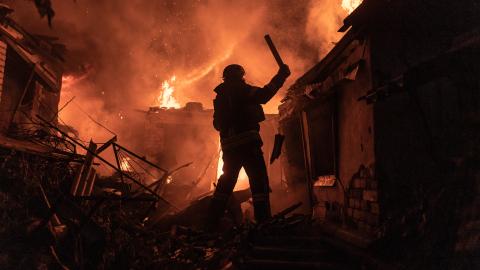Below Senior Fellow Can Kasapoğlu offers a military situation report about the war in Ukraine.
Executive Summary
• Fighting in Ukraine remains tense, particularly around Pokrovsk and Vuhledar.
• Ukrainian forces continue to occupy territory in the Russian region of Kursk.
• Ukraine introduced a new weapon system, a thermite-armed drone.
• Iran reportedly delivered Fath-360 tactical ballistic missiles to Russia.
1. Battlefield Assessment
Though Russia’s offensive is slowing in eastern Ukraine, the region remains volatile and dangerous. Ukraine has deployed National Guard formations and detachments of the Kara-Dag Brigade and the 93rd Separate Mechanized Brigade to stabilize the front and conduct tactical counteroffensives.
Nonetheless, the Kremlin has managed to gain territory. The Russian military captured Nevelske, a town near Pokrovsk, and boosted offensive action near Vuhledar. Near Niu-York, south of Toretsk, Ukraine deployed the battle-hardened Azov Brigade to break a dangerous siege and recapture territory. Yet the balance of power in this sector still favors Russia.
In the Russian region of Kursk, Ukrainian forces continue to occupy significant territory and have maintained an attritional operational tempo. General Oleksandr Syrskyi, the commander in chief of the Armed Forces of Ukraine, stated that his units now control more than 100 settlements in an area encompassing 500 square miles and stretching 21 miles inside Russia. Kyiv’s surprise campaign has reportedly also captured 600 prisoners of war.
Following an initial tactical shock, the Russian military has started to deploy firm combat formations to augment its defensive operations. Open-source intelligence suggests that the Russian General Staff has fielded detachments of naval infantry and Russian Airborne Forces (VDV) units to the Kursk region.
In southern Ukraine, Moscow has increased combat operations along the Dnipro River. But fighting there remains positional, and a significant territorial shift remains unlikely. Still, Russia continues to target Ukrainian population centers. Last week, Russian missiles struck and killed civilians, including children, in Lviv. Another attack on Poltava claimed the lives of more than 50 Ukrainian soldiers and civilians. Drone-on-drone engagements also continue to occur almost daily, offering a further glimpse at the future of warfare.
2. Ukraine Introduces Thermite Drone, a New Robotic System
The Ukrainian military has introduced a terrifying new weapon system into its war with Russia: a fire-spraying thermite drone. Open-source visuals show the weapon unleashing flames onto Russian positions along tree lines, and it appears that the system is already in widespread use. Multiple Ukrainian formations, including the 60th Mechanized Brigade, the 116th Separate Mechanized Brigade, the 108th Territorial Defense Brigade, and the 42nd Mechanized Brigade are employing the drone.
The thermite drone possesses both anti-personnel and anti-materiel capabilities. It unleashes a mixture of aluminum powder and iron oxide that burns at around 4,000 degrees Fahrenheit. Available writings suggest that several Ukrainian defense firms produce thermite munitions ranging from one-pound bombs for quadcopter drones to larger five-pound and long-burning munitions.
In terms of its kinetic effects, the thermite drone is not a game-changer like the Javelin anti-tank guided missiles that menaced Russian heavy armor at the outset of the invasion. Nonetheless, it is a potent psychological warfare asset that instills fear in Russian servicemen.
This dynamic is more important than it may seem. The Kremlin’s enormous volume of ammunition, weapons, and troops gives it an advantage over Ukraine. But Russian fighters suffer from poor morale, as their high surrender rates in Kursk demonstrate. Flames sprayed from the sky certainly have the power to intimidate Russia’s poorly trained and undisciplined units, which is a considerable advantage in this war.
3. Iran Transfers Ballistic Missiles to Russia
The Wall Street Journal reported that Russia has received a large shipment of Fath-360 tactical ballistic missiles from Iran, after likely already receiving a limited number of Fateh-110 and Zolfaghar solid-fueled short-range ballistic missiles from Tehran in 2022.
The Fath-360 is a textbook tactical ballistic missile, with a design philosophy equipping it for frontline use. It has a range of 90 miles, is relatively precise, and features a 330-pound warhead. Its rapid launch cycle and low per-unit cost make it a formidable option, particularly when fired in salvos. The Fath-360 will also augment the Russian military’s stocks in a prolonged, attritional war.
Russia’s receipt of the missiles further solidifies its symbiotic relationship with Iran. The question that remains is what Iran will get in return for its delivery. A previous Hudson report analyzed possible future transactions between Tehran and Moscow; as the two countries continue to collaborate, Western leaders will need to pay closer attention to their dangerous and growing relationship.


















